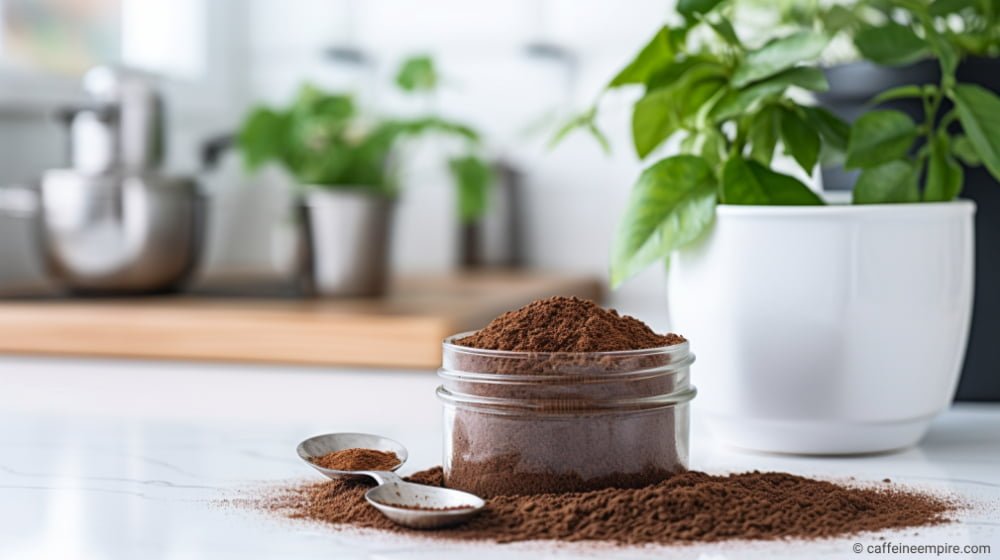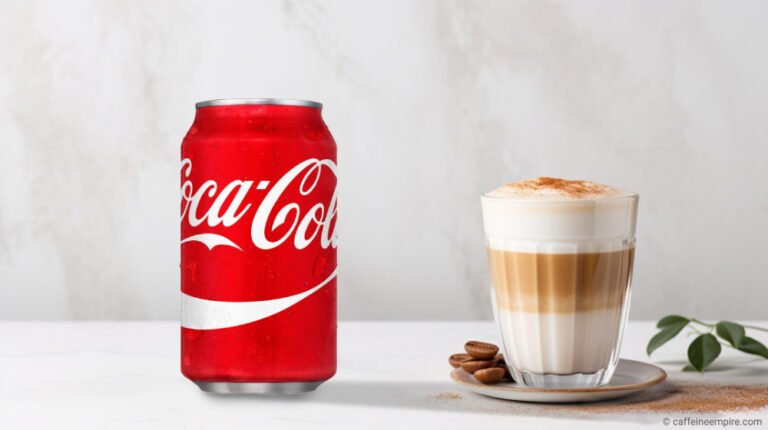Caffeine Content Of Instant Coffee
Have you ever wondered about the caffeine content in your favorite instant coffee? Well, you’re in luck because in this article, we’ll be diving deep into the world of caffeine and exploring the specific content found in instant coffee.
Now, we all know that caffeine is the magical ingredient that helps to wake us up and get us going in the morning. But have you ever stopped to think about how much caffeine is in your instant coffee? Well, let me tell you, it can vary. The caffeine content of instant coffee can range from 30 to 90 milligrams per 8-ounce cup. That’s a pretty wide range, I must say! But don’t worry, we’ll uncover the factors contributing to this variation in the upcoming article. So, if you’re curious to learn more and find out which factors affect the caffeine content of instant coffee, keep on reading!

What is Instant Coffee?
Definition of Instant Coffee
Instant coffee, also known as soluble coffee, is a type of coffee that is made from roasted coffee beans. It is a convenient and quick alternative to brewing traditional coffee. Instant coffee is made by freeze-drying or spray drying brewed coffee to remove the water content, leaving behind a residue of coffee particles that can quickly dissolve in water to create a drinkable cup of coffee.
Manufacturing Process of Instant Coffee
The manufacturing process of instant coffee involves several steps. First, the coffee beans are roasted to enhance flavor and aroma. Then, the roasted beans are ground finely to increase the surface area for extraction. Next, the ground coffee is brewed using hot water to extract the soluble compounds, including caffeine. The resulting coffee liquid is then concentrated and filtered to remove any impurities.
After filtration, the coffee liquid undergoes either freeze-drying or spray drying. Freeze-drying involves freezing the concentrated coffee liquid and then subjecting it to vacuum pressure to remove the frozen water content through sublimation. Spray drying, on the other hand, involves spraying the concentrated coffee liquid into a hot chamber where the water evaporates rapidly, leaving behind the coffee particles. Finally, the dried coffee particles are processed to achieve the desired particle size and shape, and then packaged for sale.
Understanding Caffeine
What is Caffeine?
Caffeine is a natural stimulant that is found in varying amounts in different types of coffee beans. It belongs to a class of compounds known as methylxanthines, which also include theobromine and theophylline. Caffeine acts on the central nervous system, reducing tiredness and increasing alertness.
Effects of Caffeine on the Body
When consumed, caffeine is rapidly absorbed into the bloodstream and travels to the brain. It blocks the action of adenosine, a neurotransmitter that promotes sleep and relaxation, and increases the release of other neurotransmitters such as dopamine and norepinephrine, which can improve mood and cognitive function.
The effects of caffeine can vary from person to person, depending on factors such as tolerance and sensitivity. It is known to increase wakefulness, concentration, and energy levels. However, excessive consumption of caffeine can lead to side effects such as nervousness, insomnia, and increased heart rate.
Factors Affecting Caffeine Content in Coffee
Bean Type and Quality
The type and quality of coffee beans used in the production of instant coffee can affect its caffeine content. Different coffee bean varieties, such as Arabica and Robusta, have varying caffeine levels. Arabica beans generally contain less caffeine than Robusta beans, which have a higher caffeine content. Additionally, the quality of the beans, including factors such as where they are grown and how they are processed, can also influence the caffeine content.
Roasting Process
The roasting process can affect the caffeine content of coffee. Generally, darker roasts, such as French or Italian roasts, tend to have less caffeine compared to lighter roasts. This is because the longer roasting time leads to more breakdown of caffeine during the roasting process. However, the difference in caffeine content between different roast levels is relatively small and may not significantly affect the overall caffeine content of instant coffee.
Brewing Method
The brewing method used to make the coffee liquid for instant coffee can impact the caffeine content. Different brewing methods, such as espresso or drip brewing, can extract different amounts of caffeine from the coffee beans. Espresso generally has higher caffeine content per serving compared to drip-brewed coffee.
Serving Size
The serving size of instant coffee can also affect the caffeine content. A larger serving size will contain more caffeine compared to a smaller serving size. It is important to consider the recommended serving size and adjust the amount of instant coffee used accordingly to control caffeine intake.
Measuring Caffeine Content

Methods for Caffeine Analysis
Caffeine content in coffee can be measured using various methods, including spectrophotometry, high-performance liquid chromatography (HPLC), and gas chromatography (GC). These methods involve extracting the caffeine from the coffee samples and quantifying it based on its absorbance or separation properties.
Caffeine Extraction Process
To determine the caffeine content in instant coffee, a sample is typically prepared by dissolving a specific quantity of the instant coffee granules in water. The sample is then analyzed using one of the aforementioned methods, and the caffeine content is calculated based on the results.
Caffeine Content in Instant Coffee
Comparing Instant Coffee to Regular Coffee
The caffeine content of instant coffee can vary depending on the brand and serving size. On average, a typical serving (8 fl oz) of instant coffee contains approximately 30-90 milligrams of caffeine. This is lower than the caffeine content of regular brewed coffee, which can range from 95-165 milligrams for the same serving size.
Variations in Caffeine Content among Brands
Different brands of instant coffee may have varying caffeine content due to differences in their manufacturing processes and the types of coffee beans used. Some brands may also offer decaffeinated instant coffee options for those who prefer to limit their caffeine intake.
Health Implications
Recommended Daily Caffeine Intake
The American Academy of Pediatrics recommends that children and adolescents consume no more than 100 milligrams of caffeine per day, while adults are advised to limit their daily caffeine intake to 400 milligrams. It is important to note that these recommendations may vary depending on individual tolerance and sensitivity to caffeine.
Potential Risks and Benefits of Consuming Instant Coffee
Consuming instant coffee in moderation can be a part of a balanced diet and lifestyle. The caffeine in instant coffee can provide a temporary boost in energy and alertness. Some studies have also suggested that moderate caffeine intake may have potential health benefits, such as improved cognitive function and reduced risk of certain diseases.
However, excessive caffeine consumption can lead to negative side effects, such as insomnia, digestive issues, and increased heart rate. It is important to be mindful of personal caffeine tolerance and consume instant coffee in moderation.

Choosing Instant Coffee
Decaffeinated Instant Coffee Options
For individuals who wish to limit their caffeine intake, decaffeinated instant coffee options are available. Decaffeinated coffee undergoes a specific decaffeination process to remove the majority of caffeine while still retaining the flavor and aroma of the coffee. It is important to note that decaffeinated coffee may still contain trace amounts of caffeine, although the levels are significantly reduced compared to regular instant coffee.
Low Caffeine Instant Coffee Products
Some instant coffee brands offer products with lower caffeine content. These low caffeine options are suitable for individuals who are more sensitive to caffeine or prefer a milder coffee experience. Always check the packaging or product information to determine the caffeine content of specific low caffeine instant coffee products.
Tips for Reducing Caffeine Intake
Alternative Coffee Substitutes
For individuals looking to reduce their caffeine intake, several coffee substitutes are available, such as herbal teas and decaffeinated teas. These beverages can provide a similar taste experience without the caffeine content found in instant coffee.
Moderation in Consumption
The key to managing caffeine intake is moderation. By being aware of the caffeine content of instant coffee and adjusting the serving size accordingly, it is possible to enjoy instant coffee as part of a balanced diet while controlling overall caffeine intake. It is also advisable to avoid consuming instant coffee close to bedtime to prevent potential sleep disturbances.
Popular Instant Coffee Brands
Some popular instant coffee brands and their caffeine content are as follows:
Nescafé Classic
Nescafé Classic is one of the most well-known instant coffee brands worldwide. A typical serving of Nescafé Classic contains around 60-80 milligrams of caffeine per 1 teaspoon (2 grams) of coffee.
Folgers Classic Roast
Folgers is a popular American brand of instant coffee. A standard serving of Folgers Classic Roast contains approximately 60-70 milligrams of caffeine per 1 teaspoon (2 grams) of coffee.
Maxwell House Original Roast
Maxwell House is another widely recognized instant coffee brand. A regular serving of Maxwell House Original Roast contains around 60-70 milligrams of caffeine per 1 teaspoon (2 grams) of coffee.
Starbucks VIA Instant Coffee
Starbucks offers a variety of instant coffee products under their “VIA” brand. The caffeine content in Starbucks VIA Instant Coffee varies depending on the specific product, but a typical serving may contain around 50-70 milligrams of caffeine per 1 packet (2 grams) of coffee.
Caffeine content can vary slightly depending on factors such as the specific blend, roasting process, and serving size. Additionally, new products or changes to existing formulations may have occurred after my last update, so it’s always best to check the packaging or the brand’s official website for the most up-to-date information on caffeine content.
Conclusion
Instant coffee is a convenient and popular choice for coffee lovers. While its caffeine content may be lower than regular brewed coffee, it still provides a satisfying cup of coffee that can help boost energy and increase alertness. Understanding the factors affecting caffeine content in instant coffee and being aware of personal caffeine tolerance can guide individuals in making informed choices about their coffee consumption. Enjoy instant coffee in moderation and explore low caffeine or decaffeinated options if necessary. Cheers to a delightful cup of instant coffee!






